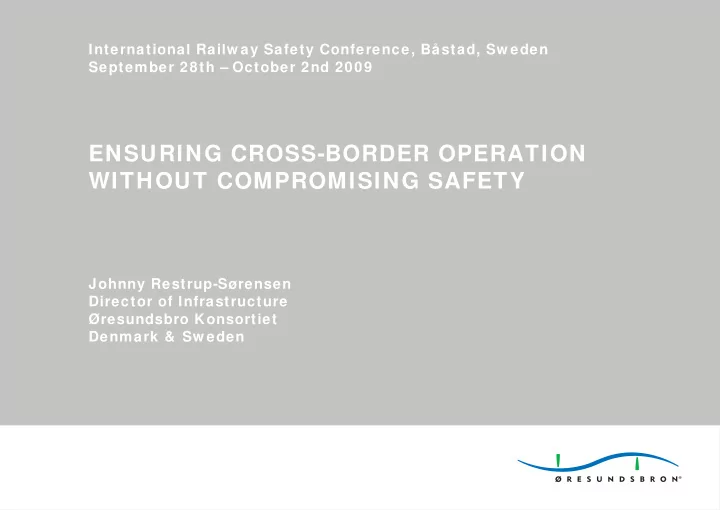

International Railw ay Safety Conference, Båstad, Sw eden September 28th – October 2nd 2009 ENSURING CROSS-BORDER OPERATION WITHOUT COMPROMISING SAFETY Johnny Restrup-Sørensen Director of Infrastructure Øresundsbro Konsortiet Denmark & Sw eden
Øresund Fixed Link alignment
Free span 490 m Sailing fairway 370 m Free high 57 m
Tunnel portal
Bridge cross section
Tw o countries – tw o technologies Main differences between Swedish and Danish systems: • Safety regulations • Signaling • Automatic train protection • Catenary's voltage and frequency • Rail inclination • Train radio systems Other problems: • Different languages
Railw ay language Long term: International railway language Short term: Danish & Swedish Important words: Swedish in Sweden and vice versa Simple words: Danish or Swedish Words to be pronounced distinctly and close to the way they are spelled Codes will be used e.g. To identify modes of operation of traction power
Cross-border train operation, the language Klart för Færdigmelding avgång “Ready for departure”
Signaling aspects Differences between Danish and Swedish signaling systems Denmark Sweden Norway Stop Stop Stop Proceed and expect Proceed with Drive from/to Stop at next signal high speed divergent track (low speed) Proceed and expect Proceed with Drive from/to 1 green at next signal max. 40 km/h main track (high speed)
Tw o countries – tw o technologies System border Change over at one “point” (on the artificial island Peberholm): • Signaling • Traffic management • Regulations • Radio system • Automatic train protection • Remote control of catenary system
Interlocking Systems on the Fixed Link Concentrators Relay interface DSB 1990 STLV85 Danish Coast Peberholm Swedish Coast System border
Operating experience • Overall safety target met in full • No accidents or potentially dangerous situations • 81 incidents in 2001 versus 70 in 2002 and 14 in 2008 errors relating to rolling stock, e.g. trains with an erroneous intercommunication system or faulty mobile ATP-equipment incorrect or inadequate safety reports between Danish and Swedish remote control centres or between the remote control centre and engine drivers infrastructure errors, primarily track circuit errors
The Øresund Safety Management System • Senior management commitment • Safety culture, policy & safety goals • Safety information • Hazard identification and risk management • Establishing a safety reporting system • Safety assessment/audit • Accident and incident reporting and investigation • Recurrent training
The basic safety process
Risk Policy • Recognize that operation will introduce risks • Identify all relevant risks • Strong risk culture among all employees • Risk acceptance criteria shall be defined • Risk level reasonable and comparable • Integrated Safety Management scheme
The four Ps of safety management Philosophy : Recognizing that there will always be threats to safety; setting the organization’s standards; and confirming that safety is everyone’s responsibility Policy : Clear statements of responsibility, authority, and accountability; development of organizational processes and structures to incorporate safety goals into every aspect of the operation; and development of the skills and knowledge necessary to do the job
Procedures : Clear direction to all staff; means for planning, organizing, and controlling; and means for monitoring and assessing safety status and processes Practices : Following well designed, effective procedures; avoiding the shortcuts that can detract from safety; and taking appropriate action when a safety concern is identified
Human factors in Cross-border operation Variations in • Language, communications, culture and social conditions • Training, selection and assessment of competence • Infrastructure technology and systems • Rules, procedures and standards • Information environment • Geographical/topographical conditions
Cross-border safety rules and standards Danish legislation Swedish legislation Banestyrelsens norms & rules Banverkets norms & rules Area 3 Area 2 Area 1 Danish legislation Danish legislation Swedish legislation and Danish traffic and Swedish traffic and Swedish traffic management management management Ownership System Territorial Ownership Border Border Border Border Kastrup Peperholm Lernacken Supplementary, more rigorous and deviating rules
Lessons learned 1. possible to create a framework for efficient and safe cross- border rail traffic between Denmark and Sweden 2. Extensive training in safety regulations and competence development in Danish and Swedish language and culture have very likely eliminated possible misunderstandings 3. The hazard identification and risk management processes provide the information needed to control risk at acceptable levels 4. The final report for the HUSARE project “Managing the Human Factor in Multicultural and Multilingual Rail Environments” has shown to be an useful tool
Thank you for your attention Johnny Restrup-Sørensen Jrs@ oresundsbron.com
Recommend
More recommend